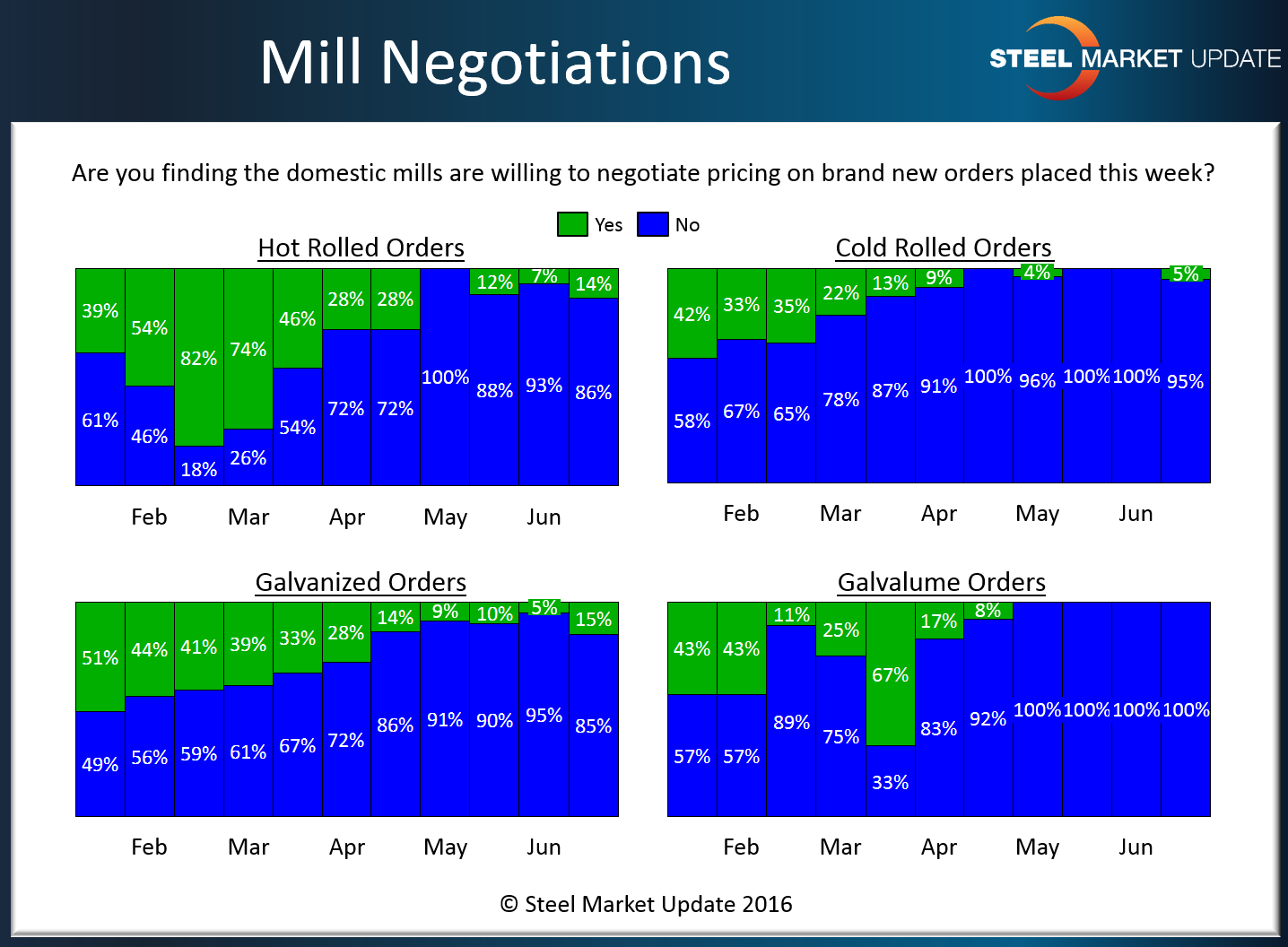SMU Data and Models

Steel Mills Barely Break a Sweat During Price Negotiations
Written by John Packard
June 19, 2016
The domestic steel mills are barely breaking a sweat as they have minimal need to negotiate flat rolled steel prices according to those taking our mid-June flat rolled steel market trends survey.
Last week we invited hundreds of companies associated with the steel industry to provide their opinions on the flat rolled steel market. Over the past couple of months our survey respondents have been telling us that there is little negotiating going on regarding hot rolled, cold rolled, galvanized or Galvalume steels.
We did note small changes in the pattern associated with hot rolled, cold rolled and galvanized. The changes are not large enough to suggest any but a blip in the data but, it is worth watching these numbers in future surveys.
Those reporting the steel mills as willing to negotiate hot rolled prices grew from 7 percent at the beginning of the month to 14 percent this past week. Cold rolled went from zero percent to 5 percent, galvanized from 5 percent to 15 percent while Galvalume remained at zero percent.
We remind our readers these results are based on responses to our survey. Each individual mill may have different approaches to negotiations and steel markets can be quite volatile and change quickly. It is important to stay close to your suppliers to make sure you are being kept up to date as to what they are doing and how your company fits into their plans.
A side note: The data for both lead times and negotiations comes from only service center and manufacturer respondents. We do not include commentary from the steel mills, trading companies, or toll processors in this particular group of questions.
To see an interactive history of our Steel Mill Negotiations data, visit our website here.

John Packard
Read more from John PackardLatest in SMU Data and Models

SMU Scrap Survey: Sentiment Indices rise
Both current and future scrap sentiment jumped this month, though survey participants reported responses before key trade news was announced.

SMU Survey: Sentiment splits, buyers have better view of future than the present
SMU’s Steel Buyers’ Sentiment Indices moved in opposite directions this week. After rebounding from a near five-year low in late June, Current Sentiment slipped again. At the same time, Future Sentiment climbed to a four-month high. Both indices continue to show optimism among buyers about their company’s chances for success, but suggest there is less confidence in that optimism than earlier in the year.

SMU scrap market survey results now available
SMU’s ferrous scrap market survey results are now available on our website to all premium members. After logging in at steelmarketupdate.com, visit the pricing and analysis tab and look under the “survey results” section for “ferrous scrap survey” results. Past scrap survey results are also available under that selection. If you need help accessing the survey results […]

SMU flat-rolled market survey results now available
SMU’s latest steel buyers market survey results are now available on our website to all premium members. After logging in at steelmarketupdate.com, visit the pricing and analysis tab and look under the “survey results” section for “latest survey results.” Past survey results are also available under that selection. If you need help accessing the survey results, or if […]

SMU Survey: Sheet lead times stabilize, plate contracts
Mill lead times for sheet products were steady to slightly longer this week compared to our late June market check, while plate lead times contracted, according to steel buyers responding to this week’s market survey.

